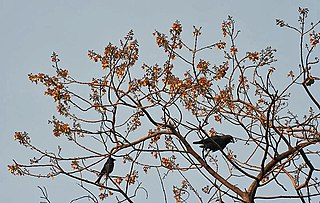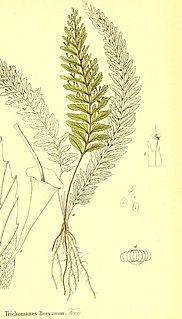
The Celastraceae, are a family of 96 genera and 1,350 species of herbs, vines, shrubs and small trees, belonging to the order Celastrales. The great majority of the genera are tropical, with only Celastrus, Euonymus and Maytenus widespread in temperate climates, and Parnassia (bog-stars) found in alpine and arctic climates.

Zanthoxylum is a genus of about 250 species of deciduous and evergreen trees, shrubs and climbers in the family Rutaceae that are native to warm temperate and subtropical areas worldwide. It is the type genus of the tribe Zanthoxyleae in the subfamily Rutoideae. Several of the species have yellow heartwood, to which their generic name alludes.

Gmelina is a genus of plants in the family Lamiaceae. It consists of about 35 species in Australia, New Guinea, New Caledonia, Southeast Asia, India and a few in Africa. Some species such as G. arborea have been planted and/or become naturalised in India, Africa and Australia. It was named by Carl Linnaeus in honour of botanist Johann Georg Gmelin.

Helicia is a genus of 110 species of trees and shrubs, constituting part of the plant family Proteaceae. They grow naturally in rainforests throughout tropical South and Southeast Asia, including India, Sri Lanka, Indochina, Peninsular Malaysia to New Guinea and as far south as New South Wales.

Ternstroemia is a genus of flowering plants in the family Pentaphylacaceae. It is distributed in tropical and subtropical regions in Africa, Asia, and the Americas.

Thelypteris is a genus of ferns in the subfamily Thelypteridoideae, family Thelypteridaceae, order Polypodiales. Two radically different circumscriptions of the genus are in use as of January 2020. In the Pteridophyte Phylogeny Group classification of 2016, the genus is a very small one with about two species. In other approaches, the genus is the only one in the subfamily Thelypteridoideae, and so includes between 875 and 1083 species.

Trichomanes is a genus of ferns in the family Hymenophyllaceae, termed bristle ferns. The circumscription of the genus is disputed. All ferns in the genus are filmy ferns, with leaf tissue typically 2 cells thick. This thinness generally necessitates a permanently humid habitat, and makes the fronds somewhat translucent.

Trochocarpa is a genus of shrubs or small trees, of the plant family Ericaceae. They occur naturally through coastal and montane eastern Australian rainforests and mountain shrublands and in New Guinea, Borneo and Sulawesi (Malesia).

Aceratium is a genus of about 20 species of trees and shrubs of eastern Malesia and Australasia from the family Elaeocarpaceae. In Australia they are commonly known as carabeens. They grow naturally in rainforests, as large shrubs to understorey trees and large trees.
Helicia lamingtoniana, also named Lamington's silky oak, is a species of rainforest trees, of northeastern Queensland, Australia, from the flowering plant family Proteaceae.
Plants of the World Online is an online database published by the Royal Botanic Gardens, Kew. It was launched in March 2017 with the ultimate aim being "to enable users to access information on all the world's known seed-bearing plants by 2020". The initial focus was on tropical African Floras, particularly Flora Zambesiaca, Flora of West Tropical Africa and Flora of Tropical East Africa.

Cephalomanes atrovirens is a species of fern in the family Hymenophyllaceae. The genus Cephalomanes is accepted in the Pteridophyte Phylogeny Group classification of 2016, but not by some other sources. As of October 2019, Plants of the World Online sank the genus into a broadly defined Trichomanes, while treating the subtaxa of this species as the separate species Trichomanes acrosorum, Trichomanes atrovirens, Trichomanes boryanum and Trichomanes kingii.
Syngramma is a genus of ferns in the subfamily Pteridoideae of the family Pteridaceae. Species are native to south-east tropical Asia and the Pacific.

Amauropelta is a genus of ferns in the family Thelypteridaceae, subfamily Thelypteridoideae, in the Pteridophyte Phylogeny Group classification of 2016. Other sources sink the genus into a very broadly defined genus Thelypteris.

Goniopteris is a genus of ferns in the family Thelypteridaceae, subfamily Thelypteridoideae, in the Pteridophyte Phylogeny Group classification of 2016. Other sources sink Goniopteris into a very broadly defined genus Thelypteris.
Sphyrospermum is a genus of flowering plants belonging to the family Ericaceae.

Loeseneriella is a genus of flowering plants belonging to the family Celastraceae.
Bejaria is a genus of flowering plants belonging to the family Ericaceae.
Cheiloclinium is a genus of flowering plants belonging to the family Celastraceae.
Conostegia is a genus of flowering plants belonging to the family Melastomataceae.












